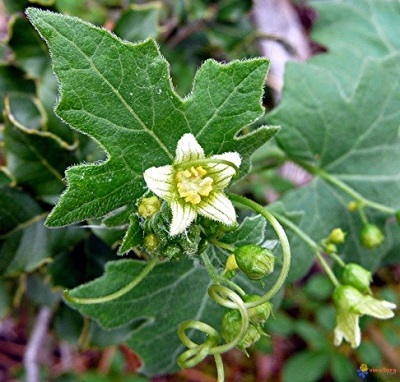White bryony- September 2019
Download weed post on white bryony (Bryonia alba) as a PDF (includes word puzzle)

White bryony leaf and flower.
White bryony is a poisonous plant with foliage and fruit that closely resembles edible grapes. We hope this Monthly Weed Post will help people recognize white bryony that might be growing in their yard or neighborhood. Identification is especially important for those of you who like to forage or have small children that could mistake white bryony for grapes or other edible fruit.
Identification
White bryony is a non-native perennial herbaceous vine. Leaves are simple, palmate, and broadly toothed. Flowers are greenish white or pale yellow, up to ½ inch in diameter. Berries are initially light green and change to black when mature (Figure B), closely resembling a Montana native, riverbank grape (Vitis riparia. Figure D, E, F). Unlike riverbank grape, white bryony has small white glands or dots on the surface and underside of the leaves (Figure C). White bryony does not have a woody stem like riverbank grape (Figure D).

White bryony and riverbank grape.
Impacts
Described as the “Kudzu of the West,” white bryony grows rapidly, as much as 6” per day. Infestations growing on small trees and shrubs can eventually block all light to the host plant. Dense infestations of white bryony on shrub or tree hosts causes snow to accumulate on the limbs, leading to breakage or loss of branches, which can make the host susceptible to disease and insects. White bryony berries are poisonous. Human fatality has been reported when less than 40 berries were consumed.
Habitat
The plant generally occurs as a climber in trees and fence rows. It was introduced as an ornamental and used primarily in horticultural plantings, so it is commonly found in yards and old homesteads.
Spread
Birds consume the seed and spread it widely. The plant is often found growing beneath places where birds perch such as fencelines, trees, and powerlines.
Management priorities
White bryony is not listed as a noxious weed in Montana, but it is listed in Idaho, Oregon, and Washington. If you find this plant in your neighborhood, we strongly recommend removing it. Digging up the root is the most effective control method and should be done in autumn after the leaves have died back. The roots must be severed 3-4 inches below the soil surface. Watch for new plants or re-growth and repeat root severing as often as necessary. Wear protective gear (gloves, long sleeves, etc.) when handling the plant, as it can irritate the skin.
